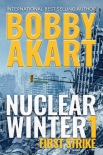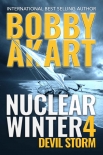Nuclear Winter First Strike Bobby Akart (children's ebooks free online .txt) 📖

- Author: Bobby Akart
Book online «Nuclear Winter First Strike Bobby Akart (children's ebooks free online .txt) 📖». Author Bobby Akart
And then as a punctuation mark—a great, big exclamation point—a massive fireball would rise high into the stratosphere, carrying with it the bowels and guts of the once proud city and its inhabitants. A massive act of cremation of the dead corpses and the homes where they lived.
This was Tehran after the Israeli nuclear counterstrike. The Supreme Leader of Iran, the highest political and religious authority of the Islamic Republic, together with his Ayatollah advisers, was ready to administer justice. He needed to punish the Jews. Once that succeeded, he would turn his ire on the Americans. Death to Israel! Death to America! A mantra that was repeated a million times a day in Tehran.
Except he miscalculated.
He chose to believe the words of the scientists who’d recently been killed at Isfahan when they said their first-strike capability against Israel would be successful. He chose to believe his admired generals within the Iranian Revolutionary Guard, who assured him they had the capability to defend Iran from Israel’s counterattack. He chose to trust Allah, who told him those who might perish would rise to face the great resurrection followed by guaranteed admittance into Heaven.
He was wrong.
Iran pulled their nuclear trigger. In the first wave of their attack on Israel, they fired four fifty-kiloton warheads via Shabab 3 missiles upon Tel Aviv and two more upon Haifa up the coast. Tel Aviv was located on a flat, open plain with a high population density, making it the Iranians’ most likely target. Haifa, because of its population, was the next likely target. Jerusalem, because of its thirty-five percent Muslim population, was spared.
The superior Israeli anti-missile and anti-aircraft defenses performed admirably against the surprise attack but not perfectly. Both Tel Aviv and Haifa were struck with a nuclear warhead. The cities were devastated, but not destroyed. The aftermath would be another issue.
In Iran, its cities were particularly vulnerable to nuclear attack due to geography, building construction, and population densities. Israel was merciless in their counterattack, sending several one-megaton warheads at Tehran just seconds behind a cluster of Jericho 1 and 2 missiles to draw Iranian defenses. While the Russian-made S-300 missile defense system knocked down most of the Jericho missiles, they were preoccupied when the nuclear-armed cruise missiles arrived.
Tehran, with its thirteen million inhabitants and fifty percent of the republic’s manufacturing and education facilities, never stood a chance. The simultaneous detonations obliterated the city.
The limited nuclear war, which was over in hours, had long-lasting effects on the planet, especially in Tehran. The topography, specifically the mountains around Tehran, obstructed the distribution of the blast caused by the nuclear explosion, forcing the debris upward. This, coupled with climatic conditions that included high concentrations of airborne dust, exacerbated the size of the mushroom cloud.
The massive hot bubble of gas rose in the form of a fireball, carrying with it debris and radioactive material. Within days, it would have circumnavigated the planet.
Part III
One Week in October
Day three, Sunday, October 20
Chapter Fifteen
Sunday, October 20
White House
Washington was in a frenzy. Staffers working at the White House, the State Department, the DOD, and Homeland Security were all called in on a Sunday as the world reeled from the nuclear war that had broken out between Israel and Iran. Years later, it would be known as the Six-Day War although for all intents and purposes, it was over in six hours.
The delusional Iranians still had a lot of fight in them. Despite Tehran being leveled from the twin nuclear detonations delivered by Israel, the Iranians had planned a ground attack coupled with naval activity in the Persian Gulf. They were seemingly prepared to do battle in the region regardless of the consequences for the Iranian people, who never had a chance.
The Iran Navy, led by Commodore Hossein Mohammed, was a small but formidable force. They’d war-gamed a blockade of the Strait of Hormuz as the cruise missiles began to fly. This action was consistent with their prior threats of stopping the flow of oil out of the Middle East and permanently forcing the U.S. out of the region.
Had the attack occurred a day later, the USS Georgia would’ve been positioned in the middle of the Persian Gulf and ready to join the fight. The Nimitz Carrier Strike Group, steaming toward the region, was still a day away. Had it been in position, there would no longer be an Iranian Navy, assuming the president gave the order to join the fray.
The level of stress in the White House was at its highest since the days of the Cuban Missile Crisis. The Kennedy administration had engaged in a thirteen-day political and military standoff with Nikita Khrushchev and the Soviet Union in October of 1962.
The U.S.S.R. had attempted to deliver nukes to Cuba, but not in the same manner of delivery as Iran and Israel exchanged. As Soviet ships steamed toward the tiny island nation just ninety miles from the Florida Keys, the U.S. moved into position to initiate a blockade in their path. The world held its breath as the nations came to the brink of all-out nuclear war. The standoff ended, in that instance, with diplomacy.
It was a different world now. In 1962, only two nations maintained nuclear stockpiles. Today, there were ten countries—the U.S., the UK, Russia, France, China, Pakistan, India, Israel, North Korea, and, with help from its allies, Iran.
In theory, any nation with the technology, intelligence, and facilities could develop nuclear weapons. Nations like Russia, China, and North Korea had been accused of facilitating the development of nuclear programs in Iran and, most recently, in Syria. It had also been rumored that China and Russia had worked with Venezuelan dictators to position nuclear warheads on the South American continent.
A new arms race had begun as the mid-twenty-first century




Comments (0)